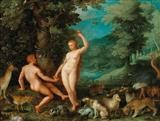Jan Brueghel I
(Brussels 1568–1625 Antwerp)
The Temptation of Adam in Paradise,
oil on panel, 36.5 x 47.5 cm, framed
Provenance:
Private collection, Italy;
sale, Dorotheum, Vienna, 13 April 2011, lot 457;
Private European collection
Literature:
K. Ertz, C. Nitze-Ertz, Jan Brueghel d. Ä., Kritischer Katalog der Gemälde, vol. IV, Lingen 2010, pp. 1651–1652, fig. 17
The present composition, which is accompanied by a certificate from Klaus Ertz, remained unpublished until 2010 and is an important addition to the artist’s oeuvre. Klaus Ertz writes: ‘In the 1590s, Jan Brueghel the Elder painted his first paradise landscapes. He established a genre of its own, which, as we now know, was highly successful particularly in seventeenth-century Flemish painting and among the artist’s followers.’
The earliest example of this genre, dated 1595, is now preserved in the Galleria Doria Pamphilj in Rome. A paradise landscape with Noah’s Ark dates from the following year (private collection, Italy). Ertz: ‘These two early paradise landscapes are the prototypes, so to speak, for all the subsequent ones: the large apple tree with the figures of Adam and Eve, most often placed in the centre, frequently amidst some landscape scenery; the view into the distance, either right or left of the tree; the accumulation of animals in the foreground, varying depending on the time when the picture in question was made. The sources for the early animal models are unclear: Jan the Elder must partly have relied on his own observations and partly have borrowed from artists such as Peter Paul Rubens or Gonzales Cock.’
Ertz writes about the dating of the present painting: ‘That the painting in question was made at an early date is illustrated both by the animals, which only occur in this form in the 1590s, and the two figures. It is generally assumed that Sadeler’s engraving after de Vos served as a model for the present and subsequent examples.’
Ertz compares this painting with the following works:
1) Paradise Landscape with the Fall of Man (Staatsgalerie Neuburg an der Donau, which dates from 1596 and was done with the participation of Hendrick de Clerck);
2) Paradise Landscape with the Fall of Man (Museo del Prado, Madrid, before 1612, with the participation of Hendrick de Clerck);
3) Paradise Landscape with the Fall of Man (circa 1612, French private collection)
Klaus Ertz writes about the figures: ‘That the figures in the present picture are not by the hand of de Clerck – although they greatly rely on his art – but were probably painted by Jan the Elder himself is suggested by the evident differences in style; compared to the nude figures by de Clerck, with their muscular physiques being accentuated by light and shadow, they are softer and not as heavily modelled.’
View it on
Sale price
Estimate
Time, Location
Auction House
(Brussels 1568–1625 Antwerp)
The Temptation of Adam in Paradise,
oil on panel, 36.5 x 47.5 cm, framed
Provenance:
Private collection, Italy;
sale, Dorotheum, Vienna, 13 April 2011, lot 457;
Private European collection
Literature:
K. Ertz, C. Nitze-Ertz, Jan Brueghel d. Ä., Kritischer Katalog der Gemälde, vol. IV, Lingen 2010, pp. 1651–1652, fig. 17
The present composition, which is accompanied by a certificate from Klaus Ertz, remained unpublished until 2010 and is an important addition to the artist’s oeuvre. Klaus Ertz writes: ‘In the 1590s, Jan Brueghel the Elder painted his first paradise landscapes. He established a genre of its own, which, as we now know, was highly successful particularly in seventeenth-century Flemish painting and among the artist’s followers.’
The earliest example of this genre, dated 1595, is now preserved in the Galleria Doria Pamphilj in Rome. A paradise landscape with Noah’s Ark dates from the following year (private collection, Italy). Ertz: ‘These two early paradise landscapes are the prototypes, so to speak, for all the subsequent ones: the large apple tree with the figures of Adam and Eve, most often placed in the centre, frequently amidst some landscape scenery; the view into the distance, either right or left of the tree; the accumulation of animals in the foreground, varying depending on the time when the picture in question was made. The sources for the early animal models are unclear: Jan the Elder must partly have relied on his own observations and partly have borrowed from artists such as Peter Paul Rubens or Gonzales Cock.’
Ertz writes about the dating of the present painting: ‘That the painting in question was made at an early date is illustrated both by the animals, which only occur in this form in the 1590s, and the two figures. It is generally assumed that Sadeler’s engraving after de Vos served as a model for the present and subsequent examples.’
Ertz compares this painting with the following works:
1) Paradise Landscape with the Fall of Man (Staatsgalerie Neuburg an der Donau, which dates from 1596 and was done with the participation of Hendrick de Clerck);
2) Paradise Landscape with the Fall of Man (Museo del Prado, Madrid, before 1612, with the participation of Hendrick de Clerck);
3) Paradise Landscape with the Fall of Man (circa 1612, French private collection)
Klaus Ertz writes about the figures: ‘That the figures in the present picture are not by the hand of de Clerck – although they greatly rely on his art – but were probably painted by Jan the Elder himself is suggested by the evident differences in style; compared to the nude figures by de Clerck, with their muscular physiques being accentuated by light and shadow, they are softer and not as heavily modelled.’



